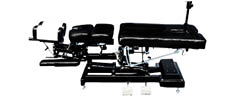:dropcap_open:C:dropcap_close:hiropractors have been utilizing Flexion–Distraction technique for over 100 years and with good results. The first flexion-distraction table was produced by an osteopath, Dr. McManis in 1909. The chiropractic profession historically has performed flexion-distraction as a therapy, that is, a very specific form of mechanically assisted traction. Enhanced flexion-distraction conversely is performed more like an adjustment.

To appreciate the differences lets first look at how flexion-distraction is traditionally taught and performed. When a conventional FD table is flexed there is approximately one inch of additional separation between the thoracolumbar and pelvic cushions. This one inch plus any lateral flexion, is the total amount of traction available. The practitioner is traditionally taught to slowly flex the table to take out the slack then slowly flex the table a little further, hold for several seconds to deliver traction then return to neutral position. This process is often repeated in three sets of four for a total of 12 cycles.
Enhanced Flexion-Distraction utilizes a modified FD table that is capable of producing over 4 inches of separation between the thoracolumbar and pelvic cushions plus the amount of traction added by lateral flexion. Practitioners of enhanced flexion-distraction also employ a significantly different type of table movement. The entire flexion movement of the table is completed over a one to two second duration which is much faster than traditionally taught. Three sets of four cycles can again be performed. The inherent movement of the modified FD table is such that the weight of the patient’s lower extremities act on a longer physical arm as the table is progressively flexed. This change in weight/arm length causes the table to flex at a rapidly increasing velocity. High speed photographic analysis (60 FPS) of the modified FD table demonstrated the short duration and rapidly increasing velocity of the flexion movement. The same high speed photographic analysis of a conventional table demonstrated flexion at a constant velocity.
Applying a force to a joint over a short duration, at an increasing velocity is the hallmark of a chiropractic adjustment. Enhanced flexion-distraction produces movement that is much more like an adjustment than just a passive therapy, resulting in frequent audible releases and subluxation correction.
For more information on the Axial Trac innovation, visit : www.axialtrac.com or call 866-998-3428.
